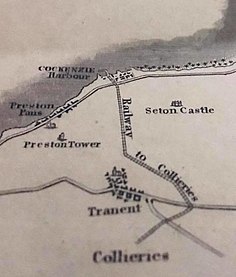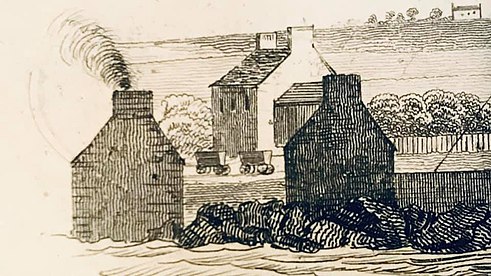Ed Bethune described the history of the Tranent to Cockenzie Waggonway from its origins and heyday in the 18th and 19th centuries, to its final demise. Originally, a wooden railway was constructed to transport coal the 2.5 miles or so from the mines around Tranent to Cockenzie Harbour and Port Seton. Some coal was used to fuel the salt pans furnaces, while the rest was exported by sea. The railway relied on gravity to run the loaded coal wagons downhill to the coast, and horses were used to pull the empty wagons back up again. The trackway runs through the site of the Battle of Prestonpans and, in 1745, the government forces made use of the cover provided by its embankments. Over time the Waggonway was extended, relaid with cast iron rails and with passing places. Generally there were three trips a day carrying coal to the coast. Passengers included someone to operate the brakes on the wagons as required, and a horse in a trolley attached to the back of the wagon train, for the return journey. After its redesign by Robert Stevenson, completed in 1833, Cockenzie Harbour had then been equipped with sets of unloading devices which tilted wagons forward to send coal down chutes into the waiting ships. In the mid 19th century, with the construction of the East Coast railway line, it became more economical to transport the coal by rail. The Waggonway continued to operate until around 1880 delivering coal to mainline railway wagons. At this time the old Waggonway, south of the main line, was replaced by a direct connection, and coal trains were then pulled by steam engines to Leith. The northern section of the Waggonway had been disused since the middle of the century and had been to some extent dismantled and the remnants covered up.
It is these remnants that the 1722 Waggonway Heritage Group was formed to explore. Archaeology work became a community project under the guidance of Ed Bethune and his colleagues. Work began in 2017 at the harbour and has since uncovered the remnants of rail trackway, turntables and loading devices. Old photographs, perhaps among the earliest photographs of any kind, reveal the layout of Stevenson’s Cockenzie Harbour and show the coal ships, trackway, wagons and coal loading structures. The heritage team with the local community have been able to locate the remains of many of the Waggonway features seen on the photographs. They have also constructed a full-size replica of a coal wagon seen in one of the photographs. In addition to the Waggonway work, the team has also been engaged in a study of the ‘salt houses’ and the seawater reservoirs cut into the rocks just below high tide level, used as a source of supply. When the tide receded, sea water was bucketed into a sluice which supplied the salt pans in the salt houses. Many of us are aware of another ‘replica’ constructed by the team – a working model of a salt pan, used to produce small amounts of salt. Small packets are sold to help fund the ongoing work.
Ed finished his talk by looking forward to the next phase of their work, which includes obtaining permission to excavate part of the trackway, now a public footpath/cycle path, which crosses the Prestonpans battle site.
Peter R


You must be logged in to post a comment.